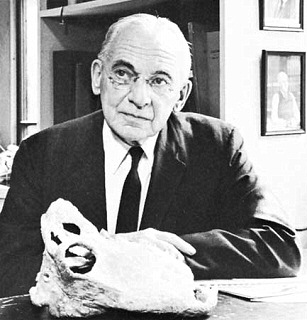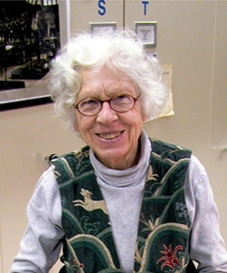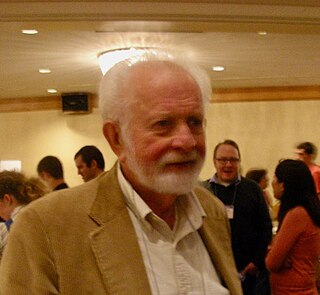Related Research Articles

Vertebrate paleontology is the subfield of paleontology that seeks to discover, through the study of fossilized remains, the behavior, reproduction and appearance of extinct vertebrates. It also tries to connect, by using the evolutionary timeline, the animals of the past and their modern-day relatives.

Alfred Sherwood Romer was an American paleontologist and biologist and a specialist in vertebrate evolution.

The Linnean Medal of the Linnean Society of London was established in 1888, and is awarded annually to alternately a botanist or a zoologist or to one of each in the same year. The medal was of gold until 1976, and is for the preceding years often referred to as "the Gold Medal of the Linnean Society", not to be confused with the official Linnean Gold Medal which is seldom awarded.

The Society of Vertebrate Paleontology (SVP) is a professional organization that was founded in the United States in 1940 to advance the science of vertebrate paleontology around the world.
Robert "Bob" Lynn Carroll was an American–Canadian vertebrate paleontologist who specialised in Paleozoic and Mesozoic amphibians and reptiles.

Mary R. Dawson was a vertebrate paleontologist and curator emeritus at the Carnegie Museum of Natural History in Pittsburgh, Pennsylvania.

Vertebrate Paleontology is an advanced textbook on vertebrate paleontology by Alfred Sherwood Romer, published by the University of Chicago Press. It went through three editions and for many years constituted a very authoritative work and the definitive coverage of the subject. A condensed version centering on comparative anatomy, coauthored by T. S. Parson came in 1977, remaining in print until 1985. The 1988 book Vertebrate Paleontology and Evolution by Robert L. Carroll is largely based on Romer's book.
The William H. Twenhofel Medal is the highest award given by the Society for Sedimentary Geology (SEPM). It was instituted in memory of William H. Twenhofel and is awarded annually to a person for his or her "Outstanding Contributions to Sedimentary Geology."

Haramiyida is a possibly paraphyletic order of mammaliaform cynodonts or mammals of controversial taxonomic affinites. Their teeth, which are by far the most common remains, resemble those of the multituberculates. However, based on Haramiyavia, the jaw is less derived; and at the level of evolution of earlier basal mammals like Morganucodon and Kuehneotherium, with a groove for ear ossicles on the dentary. Some authors have placed them in a clade with Multituberculata dubbed Allotheria within Mammalia. Other studies have disputed this and suggested the Haramiyida were not crown mammals, but were part of an earlier offshoot of mammaliaformes instead. It is also disputed whether the Late Triassic species are closely related to the Jurassic and Cretaceous members belonging to Euharamiyida/Eleutherodontida, as some phylogenetic studies recover the two groups as unrelated, recovering the Triassic haramiyidians as non-mammalian cynodonts, while recovering the Euharamiyida as crown-group mammals closely related to multituberculates.
Wann Langston Jr. was an American paleontologist and professor at the University of Texas at Austin.

William Alvin Clemens Jr. was a paleontologist at the University of California at Berkeley. He was faculty of the Department of Paleontology from 1967, then the Department of Integrative Biology from 1994 to his retirement and curator of the UC Museum of Paleontology. Clemens was also director of the museum (1987–1989) and chair of the Department of Paleontology (1987–1989). He was awarded a Guggenheim Fellowship (1974–75), a U.S. Senior Scientist Award by the Alexander von Humboldt Foundation, the Romer-Simpson Medal (2006), and was made a Fellow of the California Academy of Sciences.

The Wayan Formation is a geological formation in Idaho whose strata date back to the latest Early Cretaceous and the earliest Late Cretaceous. Dinosaur, other reptile, mammal, and micro and macro-floral remains are among the fossils that have been recovered from the formation. The lack of extensive outcrops, limited geographic extent, and extreme structural deformation have limited paleontological explorations of the Wayan.
Zhou Mingzhen, also known as Minchen Chow, was a Chinese paleomammalogist and vertebrate paleontologist. He was an academician of the Chinese Academy of Sciences, and a research professor for mammalian paleontology in the Institute of Vertebrate Paleontology and Paleoanthropology (IVPP) in Beijing. He received the Romer-Simpson Medal in 1993.

Aeluroidea, Ailuroidea or Feloidea is the name of a taxon comprising cat-like Carnivora. More specifically the taxon comprises:
Procerosuchus is an extinct genus of loricatan archosaur. Fossils have been collected from the Late Triassic Santa Maria Formation in Geopark of Paleorrota, Rio Grande do Sul, Brazil, which is Carnian in age. The genus was first described by the German paleontologist Friedrich von Huene in 1942.
The Daniel Giraud Elliot Medal is awarded by the U.S. National Academy of Sciences "for meritorious work in zoology or paleontology study published in a three- to five-year period." Named after Daniel Giraud Elliot, it was first awarded in 1917.

Edwin Harris "Ned" Colbert was a distinguished American vertebrate paleontologist and prolific researcher and author.

The Archer City Formation is a geological formation in north-central Texas, preserving fossils from the Asselian and early Sakmarian stages of the Permian period. It is the earliest component of the Texas red beds, introducing a tropical ecosystem which will persist in the area through the rest of the Early Permian. The Archer City Formation is preceded by the cool Carboniferous swamp sediments of the Markley Formation, and succeeded by the equally fossiliferous red beds of the Nocona Formation. The Archer City Formation was not named as a unique geological unit until the late 1980s. Older studies generally labelled its outcrops as the Moran or Putnam formations, which are age-equivalent marine units to the southwest.
References
- ↑ "Romer-Simpson Medal". Society for Vertebrate Paleontology. Retrieved 21 May 2014.
- ↑ Bill Clemens awarded the Romer-Simpson Medal for his contributions to vertebrate paleontology
- ↑ SOCIETY OF VERTEBRATE PALEONTOLOGY, OCTOBER 2016, ABSTRACTS OF PAPERS, 76th ANNUAL MEETING (PDF, 20,3, MB; S. 25)
- ↑ Society Of Vertebrate Paleontology, October 2018, Abstracts Of Papers, 78Th Annual Meeting
- ↑ Carroll, Lucy (15 Oct 2019) Society awards top honour to UNSW palaeontologist. Newsroom. University of New South Wales
- ↑ "Museum Paleontologist Receives Lifetime Achievement Award | Rocky Mountain PBS".